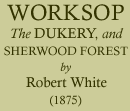< Previous | Contents | Next >

The Ancient Lords of Worksop, &c.
THE lordship of the Manor of Worksop was successively held by the De Buslis, De Lovetots, Furnivals,Talbots and Howards. With the Talbot family commenced the earldom of Shrewsbury, and the lineal connection was kept up for nearly seven hundred years. We may notice briefly a few of the incidents connected with this ancient line of nobles.
William de Lovetot was the founder of the Monastery of Worksop, and probably of the Parish Church, at Sheffield. This Church was at that time, connected with the religious establishment of Worksop. He was succeeded by his son, Richard de Lovetot, who was visited by King Stephen, at Worksop, in 1161, where he confirmed a benefaction of Malgerus de Rolleston to the Monastery at Rufford. This Richard was succeeded by his son, William de Lovetot, who married Maud, daughter of Walter Fitz-Robert, of the noble house of Clare. He was probably the founder of a Hospital for the sick at Sheffield, dedicated to St. Leonard. He died between the 22nd and 27th years of the reign of Henry II., leaving a daughter, Maud, who was married to Gerard de Furnival, a Norman knight, son of another Gerard de Furnival, who was with Richard I., at the seige of Acre. The precise time of the union does not appear; but by it the lordships of Hallamshire and Worksop came into the Furnival family. Connected with the history of this Gerard, we may add that, "whilst the eldest branch of De Lovetot ended in a female heiress, there was another branch still existing, which sprang from the first William, by his younger son Nigel." When the father of Maud died, the rights of this branch were vested in Richard de Lovetot, who seems to have acquiesced in the transit of the great property of the family to his cousin, her husband, and her issue. This Gerard went to Jerusalem, and died there, in 1219. He was succeeded by his son, Thomas de Furnival, who was slain in Palestine, where he was buried, by his younger brother and companion, Gerard: who subsequently returned thither and brought back his remains, which were interred in Worksop Church. His mother, who was then living, gave to William de Furnival, her youngest son, her Manor at Gringley, and the mill at the same place to the Convent " for the benefit of his soul." Gerard, brother to Thomas, was also buried at Worksop.
Gerard de Furnival, son of Thomas, succeeded his father, and dying without issue was succeeded by his brother, Thomas de Furnival, and he by his son, Thomas, Lord Furnival, who became a favourite with Edward the First, from whom he obtained the grant of a market and fair at Worksop, in the 24th year of that Monarch's reign. This Thomas, Lord Furnival died in 1332; his second wife who had Worksop, among several other valuable estates, for her dowry, died in 1354, when they again reverted to the family of Furnival.
Thomas, the second Lord Furnival died in 1339: he was buried at Beauchief, near Sheffield, and was succeeded by his son, Thomas, Lord Furnival, surnamed the "Hasty," who was with Edward the Third, at the battle of Cressey, in 1341: he died in 1366, and his brother, William, Lord Furnival, became heir, in whom the direct male line terminated, in 1383, leaving a daughter, Joan de Furnival, who married Sir Thomas Nevil: on her death he married Ankarat, who had been married to Richard, Lord Talbot. He died in 1406, and was buried in the Priory Church, at Worksop. Sir Thomas Nevil, Lord Furnival, had one daughter by his first wife, Maud de Nevil, who transferred the estate into another family, by her marriage with John Talbot, first Earl of Shrewsbury. He was a famous warrior, the hero of Shakespeare's play of Henry VIth, part I, and was, killed at Chatillon, on the 17th July, 1453.
It is said that his sword was found many years after his death, in the river Dordan, near Bordeaux, having on it this inscription:—
Sum Talboti. M. IIII. c. XLIII.
Pro vincere inimico meo.
John Talbot, the issue of his first marriage, succeeded to the title as second Earl of Shrewsbury: he was a warrior, and fell in the battle of Northampton, July 10th, 1460, and was buried at Worksop. In this year, and a few days before the great battle of Wakefield, there was a fight or skirmish at Worksop, which appears to have been omitted by all the chroniclers, with the exception of William of Worcester. He states that "the Duke of York, with the Earl of Salisbury, and many thousand armed men, were going from London to York, in December, 1460, when a portion of his men, the van, as is supposed, or perhaps the scouts, to the number of * * * were cut off by the people of the Duke of Somerset, at Worksop. The John Talbot last named was succeeded by his eldest son, John Talbot, third Earl of Shrewsbury. "He was more devoted to literature and the muses, than to politics and arms." He died at Coventry, in 1473, and was buried in the Lady Chapel, at Worksop. His son and heir succeeded him, as George Talbot, the fourth Earl of Shrewsbury.
